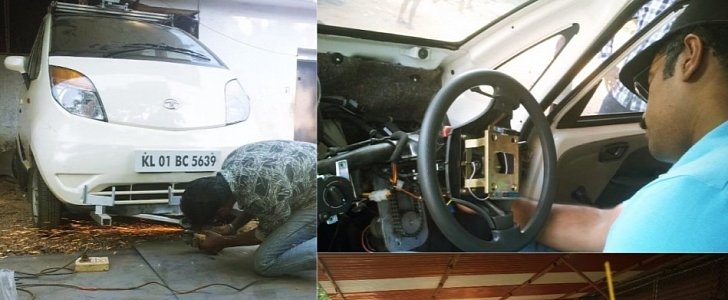Autonomous cars do not have to be expensive, as an Indian man named Roshy John has recently proved.
He developed a self-driving Tata Nano just to show that it can be done. Mr. Roshy is Practice Head at Tata Consultancy Services and was inspired to build his autonomous Tata Nano after a taxi ride that took place five years ago.
At the time, John was tired after his flight, but he realized that the driver of the taxi he was in was even sleepier than him. He offered to drive the vehicle to ensure the trip ended successfully. From that moment, he was motivated to find a way to make autonomous cars.
Interestingly, Roshy did not choose the Tata Nano because it is the cheapest production automobile in the world. Instead, he selected the Nano for its rear-engined layout, which allows him to place an array of sensors in the front of the vehicle.
Testing revealed that Indian cities pose unique challenges for autonomous cars, so he further developed the sensors used on the prototype to attain a new level of precision.
Eventually, the testing process got to actual roads, and Roshy and his small team used cameras to monitor the efficiency and responses of their self-driving system. They eventually built their full system into a new Tata Nano.
As in every project build, they envisioned their system for a vehicle with an automatic transmission, but the Nano had a manual gearbox, so they had to develop their piloted manual gearbox. European manufacturers have used this technology for a while, but the Indian approach was more direct, and less expensive.
The team claims that their system could be incorporated into any vehicle in less than an hour and provides seamless self-driving features. As the video below shows, the system appears to work, but we hope that they do not plan to strip every car interior they come across to implement their system.
We must admit we are impressed with the ingenuity shown by Roshy and his team, even though their creation might not end up in production vehicles. Nonetheless, we do hope their research reaches OE manufacturers and that their algorithms for adverse road conditions and crazy traffic get implemented in conventional self-driving cars, built by established carmakers.
At the time, John was tired after his flight, but he realized that the driver of the taxi he was in was even sleepier than him. He offered to drive the vehicle to ensure the trip ended successfully. From that moment, he was motivated to find a way to make autonomous cars.
Interestingly, Roshy did not choose the Tata Nano because it is the cheapest production automobile in the world. Instead, he selected the Nano for its rear-engined layout, which allows him to place an array of sensors in the front of the vehicle.
Testing revealed that Indian cities pose unique challenges for autonomous cars, so he further developed the sensors used on the prototype to attain a new level of precision.
Eventually, the testing process got to actual roads, and Roshy and his small team used cameras to monitor the efficiency and responses of their self-driving system. They eventually built their full system into a new Tata Nano.
As in every project build, they envisioned their system for a vehicle with an automatic transmission, but the Nano had a manual gearbox, so they had to develop their piloted manual gearbox. European manufacturers have used this technology for a while, but the Indian approach was more direct, and less expensive.
The team claims that their system could be incorporated into any vehicle in less than an hour and provides seamless self-driving features. As the video below shows, the system appears to work, but we hope that they do not plan to strip every car interior they come across to implement their system.
We must admit we are impressed with the ingenuity shown by Roshy and his team, even though their creation might not end up in production vehicles. Nonetheless, we do hope their research reaches OE manufacturers and that their algorithms for adverse road conditions and crazy traffic get implemented in conventional self-driving cars, built by established carmakers.


